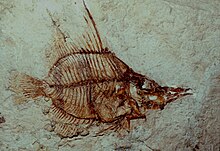オールドワイフ
| オールドワイフ | ||||||||||||||||||||||||
|---|---|---|---|---|---|---|---|---|---|---|---|---|---|---|---|---|---|---|---|---|---|---|---|---|
 ペアか大きな群れでいるのが特徴[1]
| ||||||||||||||||||||||||
| 保全状況評価[2] | ||||||||||||||||||||||||
| LEAST CONCERN (IUCN Red List Ver.3.1 (2001)) 
| ||||||||||||||||||||||||
| 分類 | ||||||||||||||||||||||||
| ||||||||||||||||||||||||
| 学名 | ||||||||||||||||||||||||
| Enoplosus armatus (J. White, 1790) | ||||||||||||||||||||||||
| シノニム[4] | ||||||||||||||||||||||||
| ||||||||||||||||||||||||
| 英名 | ||||||||||||||||||||||||
| Old wife old wives(複数形) |
オールドワイフ(学名:Enoplosus armatus)は、スズキ目エノプロスス科に分類される魚の一種。オーストラリアの沿岸固有種。エノプロスス科では唯一の現生種である(単型)[5]。
分類と名称[編集]


本種は1790 年にジョン・ホワイトによって彼の著作である『A Journal of a Voyage to New South Wales』の中で記載された[7]。ホワイトの執筆を支援したジョージ・ショーが記載者という考えもある[8]。ホワイトは当初、本種をチョウチョウウオ科の種とし、long-spined chaetodon (Chætodon armatus) と命名した[9]。その後ベルナール・ジェルマン・ド・ラセペードによって独自の属に分類され、ジョルジュ・キュヴィエによって独自の科に分類された[10]。
1836年、ルイ・アガシーはモンテ・ボルカから本種の近縁種の化石を発見し、Enoplosus pygopterus と命名した[10][11]。この種は形態や模様が本種とかなり似ており、5000万年間姿がほとんど変わっていないと分かった[6]。
「オールドワイフ(老婆)」という名前は、捕まえられると歯を用いてギシギシと音を出す事による[7]。bastard doryやdouble scalareとも呼ばれる[12]。
分布と生息地[編集]
クイーンズランド州のフレーザー島から、タスマニア島を含む西オーストラリア州まで、オーストラリア南部に分布する[13]。水深100 m以浅の岩礁や藻場、入江に生息し、幼魚は汽水域にも進出する[13]。
形態[編集]

体は側扁した楕円形で体高は高く、額は凹み吻は尖っている。これらの特徴はチョウチョウウオ科に似ている[14]。しかし背鰭、臀鰭、腹鰭が長く、第一背鰭と第二背鰭は完全に分離しているため簡単に区別できる[13]。特に第二背鰭は長く、鎌状になっている。背鰭は合計で9棘と14 - 15軟条から、臀鰭は3棘と14 - 15軟条から成る。椎骨は26個[4]。背鰭棘は鋭く、毒があり刺されると痛むとされているが、明らかな毒腺などは観察されていない[15][16]。
生態[編集]
エビやゴカイを好んで食べる。稚魚は掃除魚として他の魚の寄生虫を食べることもある[13]。普段は単独かペアだが数百匹の群れを成すこともある。
出典[編集]
- ^ Old Wife Archived 2016-03-04 at the Wayback Machine., Reef Watch Victoria.
- ^ Holleman, W.; Fennessy, S.; Russell, B. (2020). “Enoplosus armatus”. IUCN Red List of Threatened Species 2020: e.T143616007A143616622. doi:10.2305/IUCN.UK.2020-2.RLTS.T143616007A143616622.en 2024年2月15日閲覧。.
- ^ Richard van der Laan; William N. Eschmeyer & Ronald Fricke (2014). “Family-group names of Recent fishes”. Zootaxa 3882 (2): 001–230. doi:10.11646/zootaxa.3882.1.1. PMID 25543675.
- ^ a b Froese, Rainer and Pauly, Daniel, eds. (2024). "Enoplosus armatus" in FishBase. February 2024 version.
- ^ J. S. Nelson; T. C. Grande; M. V. H. Wilson (2016). Fishes of the World (5th ed.). Wiley. pp. 442–443. ISBN 978-1-118-34233-6
- ^ a b The 'Lost Language' of Fishes Archived 2012-03-18 at the Wayback Machine. (with captioned images Archived 2011-05-13 at the Wayback Machine.), Australian Research Council's Centre of Excellence for Coral Reef Studies. Colouring patterns demonstrated to have been preserved in fish (especially old wives) from at least 50 mya.
- ^ a b Morrison, Sue、Storrie, Ann『Wonders of Western Waters』Department of Conservation and Land Management、1999年、119頁。ISBN 0-7309-6894-4。
- ^ “CAS - Catalog of Fishes | Institute for Biodiversity Science and Sustainability”. 2014年3月5日時点のオリジナルよりアーカイブ。2019年12月9日閲覧。
- ^ White, J. 1790, Journal of a voyage to New South Wales with 65 plates of nondescript animals, birds, lizards, serpents, curious cones of trees and other natural productions.: Pl. 39. transcription at Gutenberg
- ^ a b L. Agassiz. 1836. Recherches Sur Les Poissons Fossiles. Tome IV (livr. 6). Imprimerie de Petitpierre, Neuchatel 53-108 [1]
- ^ Pygon+pteron. George Roberts, An etymological and explanatory dictionary of the terms and language of geology
- ^ Agustin, Liza Q. (2007年7月13日). “Common Names of Enoplosus armatus”. Common name summary. FishBase. 2009年1月3日閲覧。
- ^ a b c d “Old Wife, Enoplosus armatus (White 1790)” (英語). fishesofaustralia.net.au. 2024年2月15日閲覧。
- ^ "Most [butterflyfish, angelfish and surgeonfish] have thin, oval or disk-shaped bodies. They typically have bright colors and patterns. Butterflyfish are usually round, small and have concave foreheads. They often have long snouts for feeding from crevices." AWARE-Fish Identification, Adventures in Diving Manual, PADI (2010).
- ^ Carl Edmonds, Dangerous marine creatures, 1989. "Although it has been described as venomous, this apparently is of a variable nature as many lacerations from the knife-like dorsal spines have been known by this author to be relatively painless. It appears as if the pain and bleeding may be inversely related, ..." p.70
- ^ Smith and Wheeler, Venom Evolution Widespread in Fishes, Journal of Heredity v.97 i.3 pp.206-217 (2006).
関連項目[編集]
外部リンク[編集]
![]() ウィキメディア・コモンズには、オールドワイフに関するメディアがあります。
ウィキメディア・コモンズには、オールドワイフに関するメディアがあります。
![]() ウィキスピーシーズには、オールドワイフに関する情報があります。
ウィキスピーシーズには、オールドワイフに関する情報があります。
